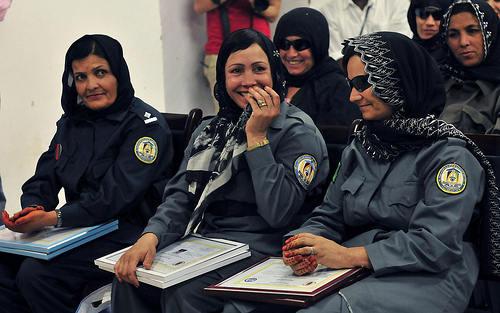Bathrooms are an important issue to me. When I present as a woman I use women’s bathrooms, and I want every trans person to have the right to choose their bathroom. But I realize that the desire some people have to exclude us from bathrooms is based on a legitimate concern. I heard this recently in a story from Afghanistan, where some people have made gender-segregated bathrooms a priority.

In Afghanistan, crimes against women often go unpunished. The Afghan government recognized that a major factor was the absence of female officers, and hired a number of new recruits. Now, many of those police officers are leaving, because they are being regularly attacked and raped.
The most common locations for these assaults are the police station bathrooms, which are open to all genders. The female officers are most vulnerable when half-naked, performing involuntary bodily functions. The proposed solution, advocated by Human Rights Watch, is to institute women-only spaces, where a man would be automatically suspect.
It’s too often overlooked that the shared bathrooms in no way cause the attacks. These attacks are deliberate acts of violence chosen by individuals, encouraged by a culture that dehumanizes women, and perpetuated by a legal system uninterested in bringing the perpetrators to justice.
This story helps some of us understand why gender-segregated bathrooms exist in the first place. They are a kludge, a short cut to stop the worst abuses. And like all kludges, bathroom segregation doesn’t work one hundred percent. There are false positives – trans people who are denied access to the bathrooms that fit our presentation and marked when we use the others. Significantly, there are plenty of false negatives – men who walk right into segregated bathrooms and attack women without any claim to transgender status.
A kludge may be necessary to break through a logjam. Think of the US Marshals who accompanied Ruby Bridges when she became the first Black student to attend William Frantz Elementary School. Segregated bathrooms may similarly be warranted in the case of the Afghan police. But just as integrated schools no longer require guards for every Black student, in some places segregated bathrooms may no longer be necessary.
Twice when I was in college here in the US I lived on dormitory floors where the bathrooms were nominally reserved for a single gender, but the residents had voted unanimously to open them to all genders. When I was studying in Paris, the public bathrooms in the classroom buildings were similarly integrated, with all gender markings removed.
Of course rape and voyeurism still exist in both the US and France, and in some places it may still be necessary to segregate bathrooms by gender. But the two experiences I mentioned suggest that in some situations respect for women’s rights and the rule of law is so secure that we no longer need the kludge of segregated bathrooms to protect women.
Even in places where gender-segregated bathrooms are still deemed necessary, it is clear that people who want to rape, ogle or video women in bathrooms will do so if they think they can get away with it. A small minority of them claim to be trans, probably because they actually are trans. In the end, what really protects women in bathrooms is not ineffective attempts to keep trans people out of them, but strong enforcement of the laws against assault and voyeurism.

